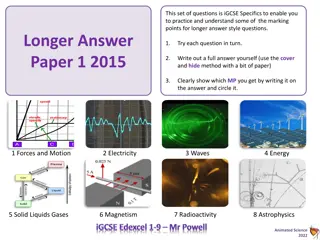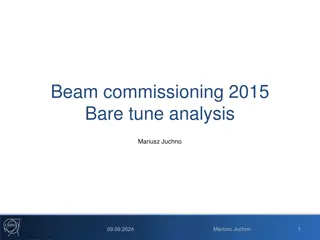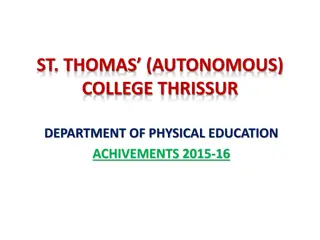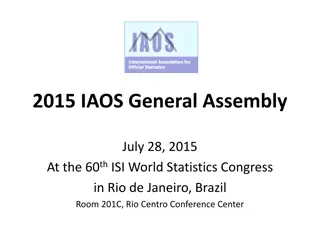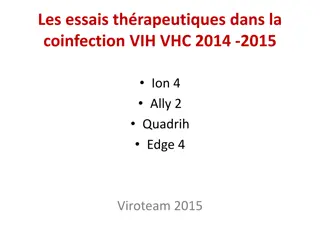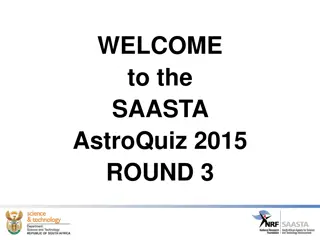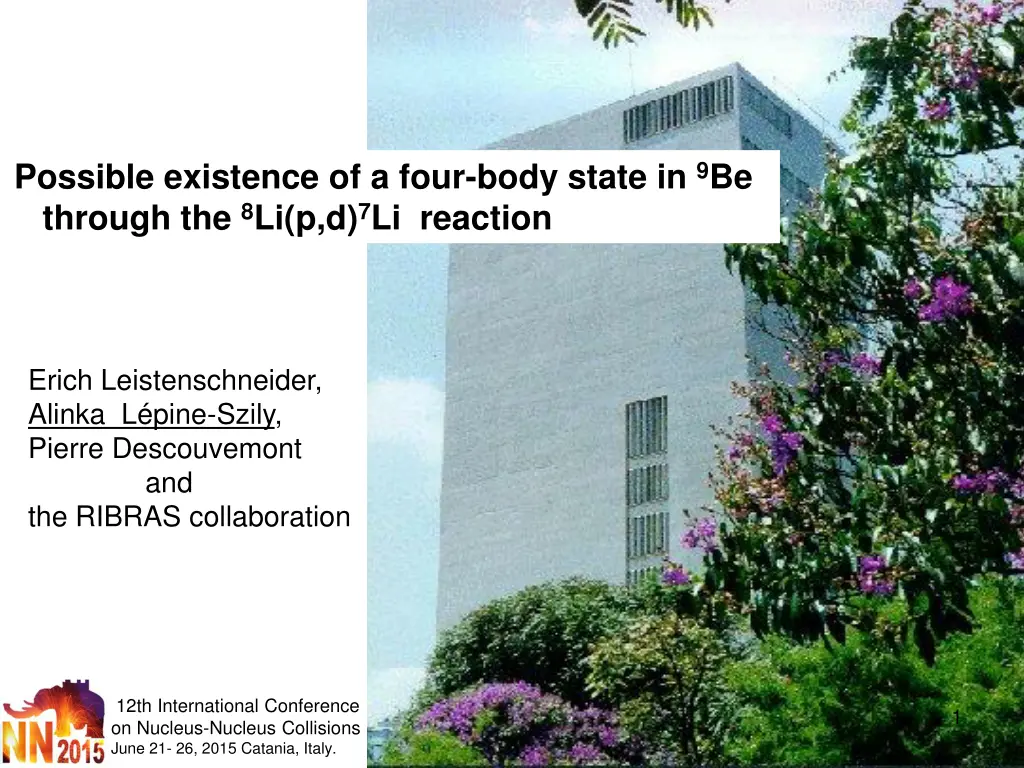
Study of Four-Body State in 9Be via 8Li(p,d)7Li Reaction and RIBRAS Facility Details
"Explore the potential existence of a four-body state in 9Be through the 8Li(p,d)7Li reaction, as presented at the 12th International Conference on Nucleus-Nucleus Collisions. Discover insights from the RIBRAS facility in Brazil, equipped with a Tandem Accelerator Pelletron 8UD. Learn about the experimental methods, results, and applications of radioactive ion beams in nuclear physics research."
Download Presentation

Please find below an Image/Link to download the presentation.
The content on the website is provided AS IS for your information and personal use only. It may not be sold, licensed, or shared on other websites without obtaining consent from the author. If you encounter any issues during the download, it is possible that the publisher has removed the file from their server.
You are allowed to download the files provided on this website for personal or commercial use, subject to the condition that they are used lawfully. All files are the property of their respective owners.
The content on the website is provided AS IS for your information and personal use only. It may not be sold, licensed, or shared on other websites without obtaining consent from the author.
E N D
Presentation Transcript
Possible existence of a four-body state in 9Be through the 8Li(p,d)7Li reaction Erich Leistenschneider, Alinka L pine-Szily, Pierre Descouvemont and the RIBRAS collaboration 12th International Conference on Nucleus-Nucleus Collisions June 21- 26, 2015 Catania, Italy. 1
Outline Description of RIBRAS Radioactive Ion Beams in Brazil. Reactions of the 8Li + p system Experimental method and results R-matrix analysis Conclusions 2
Major Facility for Nuclear Physics research in Brazil Tandem Accelerator Pelletron 8UD at the University of S o Paulo - Brazil primary beams: 6Li, 7Li , 10,11B, 9Be, 12C, 16,17,18O, ... 3 3.0 5.0 MeV/nucleon
RIBRAS - Radioactive Ion Beams in Brazil First RIB facility in the Southern Hemisphere,installed in 2004 Max field 6.5 Tesla versatile configuration persistent mode low LHe and LN2 consumption Low energy radioactive ion beam production with solenoid based system. University of S o Paulo Brazil 4
Double solenoids (cross-over mode) Second solenoid allows the production of pure secondary beams. Degrader/absorber between 2 solenoids, energy loss depends on Z2, Contaminants in 2nd solenoid have different B don t pass Second scattering chamber First scattering chamber Solenoid -1 Solenoid - 2 Beam spot FWHM=4,5mm Beam spot FWHM=7mm 5
Typical identification spectrum obtained in the second scattering chamber, after the second solenoid, with E-E Si telescope, without (A) and with (B) degrader : contaminant beams are eliminated. Transmission: ~50% 6
Present radioactive beams at RIBRAS secondary ion reaction intensity / 1 A of primary beam 6He 9Be(7Li,6He) 2 x 105p/s 8Li 9Be(7Li,8Li) 106p/s 7Be 7Be 8B 18F 17F 3He(6Li,7Be) 6x105p/s 6Li(7Li,7Be) 105p/s 3He(6Li,8B) 104p/s 12C(17O,18F) 3He(16O,17F)d 104 p/s * The production of pure secondary beams allows the study of fusion, transfer, break-up reactions 7
Exotism in nuclei: Halo structure in light nuclei for N/Z far from 1: 11Li,6He,11Be, 14Be, 8B, 17Ne..... Nuclear states with excited cores Nuclear states with cluster structures: 2,3.. 8
Study of 9Be structure through 8Li+p reactions 7Li+d ??? 8Li+p Probes 9Be around ?? 18 20 MeV High excitation energies in 9Be unknown states level density important several open channels + +n 9
8Li+p experiments at RIBRAS 2009-2011 D.R. Mendes et al., PRC 86 (2012) 064321 Validity of 2-body reaction hypothesis for 8Li(p, )5He sequential decay . 2013-14 2 solenoids pure 8Li beam 2015 8Li(p,p)8Li, 8Li(p,d)7Li, 8Li(p, )5He 2 solenoids pure 8Li beam, better statistics, in analysis 8Li(p, ) 5He, one solenoid, Q=+14.42 MeV, 8Li(p,p)8Li, 8Li(p,d)7Li, 8Li(p, )5He 10
Experimental method for measurement of reactions of the 8Li+p system using purified 8Li beam: Inverse kinematics: 8Li beam hitting a thick [CH2]n target Primary beam 7Li, accelerated by 8UD Pelletron tandem of S o Paulo to 25.9 and 27.8 MeV Production target: 16 micron 9Be foil Radioactive 8Li beam 9Be(7Li,8Li)8Be, selected by both solenoids of RIBRAS.Degrader between the solenoids. Elab= 15.8 and 18.7 MeV Radioactive beam intensity: 3x105 pps, (50% transmission from 1st to 2nd solenoid) Detection: deltaE(50 microns)-E(1000 microns), 300 mm2 silicon telescope at lab=10 Secondary Target [CH2]n Polyethylene foil 7.7mg/cm2 11
TTIK thick target inverse kinematics method: thick secondary target CH2 (7.7 mg/cm2) 8Li beam looses energy, stops in the target 4He,p,d,t Si-telescope 8Li beam ( ) E + 2 / E E = ( ) ( ) ; , idE Y E I E i ( ) E 2 / E E i E2 E1 = stopping power Simultaneous measurement of all incident energies: excitation function Resonances populated in the target peaks in energy spectrum of light ejectiles Energy spectrum of 4He, p, d excitation function of reactions Energy resolution: independent of beam dispersion, depends on energy loss of light ejectiles in target 12
Energy spectra measured on [CH2]n target at Elab=18.7 MeV 13
8Li+p 9Be 14
8Li+p 9Be 8Li(p,t) very low cross section 15
Comparison of present 8Li(p,d)7Li cross section with previous 7Li(d,p)8Li measurements 8Li(p,d)7Li : 7Li(gs) and 7Li*(0.48, 1/2-) final states not separated 7Li(d,p)8Li : Integrated cross section (8Li -decay) 8Li(gs), 8Li* not separated 7Li(d,p)8Li data: S. Bashkin, Phys. Rev. 95, 1012 (1954). C. R. McClenahan, R. E. Segel, Phys. Rev. C 11, 370 (1975). Detailed balance theorem : qualitative agreement, not isotropic 60 7Li(?,?)8Li d /d (mb/sr) 40 Strong peak in 8Li(p,d)7Li, absent in 7Li(d,p)8Li essentially populates the d+7Li* channel 20 8Li(?,?)7Li 16 0 ??.?. (MeV) 0 1 2 3
Due to 7Li* excitation (E*(7Li,1/2-)=0.478 MeV) the resonance appears at lower energy in the deuteron energy spectrum ( Ed = 1.0 MeV) 40 8Li(p,d) 7Li 35 sigma sigma shifted E*=0.478 MeV Ed=1.0 MeV Ec.m.=0.225 MeV 30 d /d (mb/sr) 25 20 15 10 E*(7Li,1/2-)=0.478 MeV Ed = 1.0 MeV Ecm = 0.225 keV 5 3 4 5 6 7 8 9 Ed(MeV) 17
R-matrix calculation Procedure: 1. Inputs for each resonance: ?,?, ,?0,??,?? 2. Calculation of the R-matrix for each J values 3. From R-matrices calculation of the scattering matrices UJ for each J 4. From the scattering matrices UJ : elastic and transfer cross sections Several reactions with the same entrance channel constrains Energy ?0, proton width ??are common constrains 4-channels: 8Li + p 5He + 7Ligs + d 7Li* (1/2-) + d ??2 8Li(p,p)8Li: ???? = ?0 ? ???? ?0 ? ???? ?0 ? 8Li(p, )5He: ???? = 8Li(p,d)7Li: ???? = 18
Multi-channel R-matrix fits to the data (4-channel) 200 8??(?,?)8?? 160 ??/? (mb/sr) R-matrix fits: 5 resonances Broad states in and d channels 120 80 40 0 0.0 0.5 1.0 ??.?. (MeV) 1.5 2.0 2.5 30 8Li(?,?)5He ??/? (mb/sr) 20 10 d=p+n 0 7Li*= +t 0.0 0.5 1.0 1.5 2.0 2.5 ?_?.?. (MeV) 40 deuteron channel: large reduced width Dominant 7Li*+d structure State with excited core +t+p+n four-body state 8Li(?,?)7Li ??/? (mb/sr) 30 20 10 0 19 Challenge for cluster models! 0.0 0.5 1.0 ??.?. (MeV) 1.5 2.0 2.5
Resonance parameters obtained from the fit: 40 200 30 160 30 ??/? (mb/sr) 120 20 20 80 10 10 40 0 0 0 0.0 0.5 1.0 ??.?. (MeV) 1.5 2.0 2.5 0.0 0.5 1.0 ??.?. (MeV) 1.5 2.0 2.5 0.0 0.5 1.0 1.5 2.0 2.5 ?cm(MeV) 20 8??(?,?)8?? 8Li(?,?)7Li 8Li(?,?)5He
Conclusions The use of the two solenoids with a degrader makes possible the production of pure secondary beams at RIBRAS. The simultaneous measurement of the resonant elastic scattering and other reaction channels as (p, ), (p,d) constrains the resonance parameters of 9Be. New resonance with large reduced deuteron width observed in deuteron channel. Dominant 7Li*+d structure State with excited core and possible +t+p+n four-body state. 21
Thank you for your attention Erich Leistenschneider, Alinka L pine-Szily, Pierre Descouvemont , Djalma R. Mendes Jr., and 22
Superconducting Solenoid Magnet NbTi Field integral 5 T.m. Max. central field 6.52 T Max. current 91.86 A Inductance 309 H Stored Energy 1.3 MJ LHe vessel 250 litros LHe boil-off rate 3.4 liters/day LN2 Vessel 130 Litros LN2 15 liters/day 80K 73K N2 He 4K40K B Fabricant: Cryomagnetics Inc, Oak Ridge USA 23
Energy spectrum measured at Elab=19.0 MeV 12C( , )12C p(8Li, )5He Kinematic variation of energy centroids of large peak with angle, compared to calculations Conclusion: The large peak at E =27 MeV is due to p(8Li, )5He 26
Resonance with strong structure 30 ??/? (mb/sr) Inelastic scattering 9Be(p,p ) with 180 MeV p beam. Dixit et al, Phys.Rev.C43, 1758(1991) 20 8Li(?,?)5He 10 0 0.0 0.5 1.0 1.5 2.0 2.5 ?_?.?. (MeV) Resonance with strong 7Li* +d structure 40 ? / (mb/sr) 30 8Li(?,?)7Li 20 10 0 27 0.0 0.5 1.0 1.5 2.0 2.5 ??.?. (MeV)




